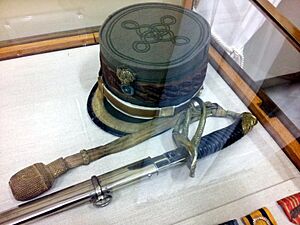Leonidas Paraskevopoulos facts for kids
Quick facts for kids
Leonidas Paraskevopoulos
Λεωνίδας Παρασκευόπουλος |
|
|---|---|

Leonidas Paraskevopoulos c. 1920
|
|
| Native name |
Leonidas Paraskevopoulos
Λεωνίδας Παρασκευόπουλος |
| Born | 7 October 1860 Kythnos, Kingdom of Greece |
| Died | 16 May 1936 (aged 75) Paris, French Third Republic |
| Allegiance | |
| Service/ |
|
| Years of service | 1878-1920 |
| Rank | |
| Unit | Army of Thessaly |
| Commands held | 2nd Field Artillery Regiment 2nd Infantry Division Army of Epirus 10th Infantry Division I Army Corps Army of Asia Minor |
| Battles/wars | Greco-Turkish War (1897)
|
| Awards | |
| Alma mater | Hellenic Military Academy |
| Other work | President of the Greek Senate |
Leonidas Paraskevopoulos (Λεωνίδας Παρασκευόπουλος) was an important Greek army officer and politician. He was born on October 7, 1860, and passed away on May 16, 1936. He played a big part in Greece's efforts during World War I. He also led the Greek army in Asia Minor from 1919 to 1920. Later in his life, he became a member of the Greek Senate, which is like a part of the government. He even served as its leader from 1930 to 1932.
Contents
Leonidas Paraskevopoulos: A Greek General
Early Life and Military Training
Leonidas Paraskevopoulos was born on October 7, 1860, on the island of Kythnos in Greece. His family originally came from Smyrna, a city in Asia Minor.
He joined the Hellenic Military Academy, which is a school for army officers. He finished his training in November 1881. He became a 2nd Lieutenant in the Artillery. Artillery soldiers operate large guns and cannons.
Fighting in the Balkan Wars
During the Greco-Turkish War of 1897, Leonidas Paraskevopoulos was part of a special group sent to Crete. This group was led by Colonel Timoleon Vassos.
Later, in the First Balkan War (1912–1913), he first led the 2nd Field Artillery Regiment. This unit was in charge of many cannons. At the Battle of Sarantaporo, he was put in charge of all the artillery for the Army of Thessaly. He kept this important job until the city of Thessaloniki was captured.
After that, he became the commander of the 2nd Infantry Division. An infantry division is a large group of foot soldiers. He then became the Chief of Artillery for the Army of Epirus. He was very important in the successful Battle of Bizani, which led to the capture of Ioannina. In April 1913, he took command of the new 10th Infantry Division. He led this division during the Second Balkan War against Bulgaria. His division fought in the Battle of Doiran.
Role in World War I
In World War I, Paraskevopoulos became the commander of the I Army Corps. This was a large army unit. He was stationed on the Macedonian front from 1917 to 1918. In October 1918, he was made the commander-in-chief of the entire Greek Army. This meant he was the main leader of all Greek forces.
Commander in Asia Minor
After World War I, Paraskevopoulos directly led the Greek forces that took control of Smyrna in 1919. This was part of the Treaty of Sèvres, an agreement signed after the war. Under his leadership, the Greek Army successfully expanded its control. They moved from the Smyrna area south to Aydın and north to Bursa.
Later Life and Politics
In November 1920, a new political group won the elections in Greece. Because of this, Leonidas Paraskevopoulos was removed from his military position on November 25, 1920.
After the Greco-Turkish War (1919–1922) ended, Paraskevopoulos started a career in politics. In 1929, he was chosen to be a member of the Greek Senate. The Senate is a group of experienced people who help make laws and govern the country. He served as the President, or leader, of the Senate from 1930 to 1932.
He passed away on May 16, 1936, in Paris, France. He was 75 years old. He received the Serbian Order of the White Eagle for his service.


